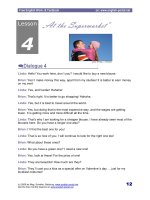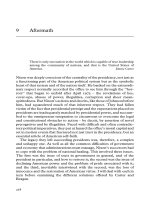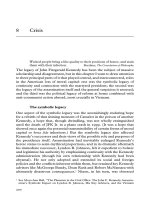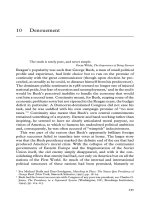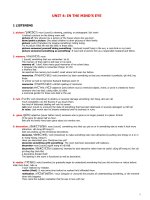4 13 the american economy
Bạn đang xem bản rút gọn của tài liệu. Xem và tải ngay bản đầy đủ của tài liệu tại đây (3.02 MB, 10 trang )
Fascinating Facts
• A living person cannot have his or her picture on a
United States bill.
• Some words that people sometimes use for money are
bread, bucks, greenbacks, jack, and dough.
• The United States Mint makes about 20 million pennies
each day.
Genre
Nonfiction
Comprehension Skill
Cause and Effect
Text Features
• Chart
• Sidebars
• Captions
Scott Foresman Social Studies
ISBN 0-328-14848-2
ì<(sk$m)=beieig< +^-Ä-U-Ä-U
In this book you will be introduced to the
workings of the United States economy and
the role that you play in our nation and world’s
economies. You will read about the variety
of goods and services that can be bought and
sold and the choices that they represent for
consumers.
Vocabulary
economy
goods
services
consumer
producer
supply
demand
tax
globalization
Write to It!
Think of a good or service that you would like
to provide in your community. What would it
be? How might you produce it? How would you
figure out how much to charge? What would be
a good way to advertise it? Write two paragraphs
that answer these questions.
Write your paragraphs on a separate sheet of paper.
Photographs
Every effort has been made to secure permission and provide appropriate credit for photographic material. The publisher deeply
regrets any omission and pledges to correct errors called to its attention in subsequent editions.
Unless otherwise acknowledged, all photographs are the property of Scott Foresman, a division of Pearson Education.
Photo locators denoted as follows: Top (T), Center (C), Bottom (B), Left (L), Right (R) Background (Bkgd)
ISBN: 0-328-14848-2
Copyright © Pearson Education, Inc.
All Rights Reserved. Printed in the United States of America. This publication is protected
by Copyright, and permission should be obtained from the publisher prior to any prohibited
reproduction, storage in a retrieval system, or transmission in any form by any means,
electronic, mechanical, photocopying, recording, or likewise. For information regarding
permission(s), write to: Permissions Department, Scott Foresman, 1900 East Lake Avenue,
Glenview, Illinois 60025.
1 2 3 4 5 6 7 8 9 10 V0G1 14 13 12 11 10 09 08 07 06 05
Opener: ©Greg Pease/Getty Images
2 ©Getty Images, ©Stephen Oliver/DK Images
3 ©David Young-Wolff/PhotoEdit
4 ©Getty Images
6 ©James Leynse/CorbisEditorial Offices: Glenview, Illinois • Parsippany, New Jersey • New York, New York
7 ©AFP/Getty Images
9 ©Owen Franken/CorbisSales Offices: Needham, Massachusetts • Duluth, Georgia • Glenview, Illinois
10 ©Ted Wood/Getty Images
Coppell, Texas • Sacramento, California • Mesa, Arizona
13 ©Brand X Pictures
14 ©Greg Pease/Getty Images
The dog groomer is a producer
with a service to sell. The dog
owner is a consumer buying
that service.
Goods and Services
Economics is a complex term. Even experts disagree
on its complete meaning. When you buy something,
you are taking part in the economy, a system of
buying and selling goods and services. Goods include
sporting equipment, books, CDs, and clothing—
almost anything that you can hold or touch. Services
include things such as piano lessons, haircuts, and
airplane trips—things that you cannot actually touch
or hold.
In different parts of the world, many different items
have been used as money. The first coins were used
some 2,600 years ago along the border where Europe
meets Asia. About 1,400 years ago, the Chinese
began using paper money.
These are all examples of
goods that are bought and sold.
2
Consumers
and Producers
All people are
consumers. This means
that they buy goods and
services that they need
or want.
Some people are also
producers. They make
or provide goods and
services and sell them
to consumers. Producers such as bakers, farmers, CD
makers, and car manufacturers provide goods. Examples
of producers who provide services are teachers, barbers,
pilots, and dentists.
Producers and consumers depend on one another.
Without producers, there would be no goods and
services to buy. Without consumers, there would be
no one to buy those goods and services. A healthy
economy requires a balance between production and
consumption. There must be enough goods available
to most consumers who want to purchase them, but not
so many that a large number of goods remain unsold.
3
Needs and Wants
The goods and services that people must have to
live are called needs. Needs include food, a place to
live, and clothing. Wants are goods and services that
we would like to have but that are not necessary for
living. For example, foods such as bread and fruit are
needs, but things like ice cream and CDs are wants. A
warm, safe home is a need, but a huge house with a
swimming pool is a want.
You probably have your own list of wants. These
wants usually must wait until you have what you need.
Shoppers today have many choices. Wise consumers read
and listen to advertisements carefully.
4
In the past, people produced almost all the goods
they needed by themselves. We now depend on each
other to produce most goods and provide services.
Choices
Consumers constantly have to make choices because
no one can buy everything that he or she wants. If you
have money to spend, you might want to buy a book
and a CD. You may not have enough money for both,
however, so you will have to choose one.
How do people decide what to spend their money
on? In the United States, there are many choices. For
instance, a grocery store may have nearly twenty-five
different kinds of cereal on its shelves. The producers
of these cereals want consumers to know about their
products, so they hire advertisers. Advertisers are
experts in providing information about products.
This skill is the service they have to sell. They create
advertisements, or ads, for magazines, newspapers,
radio, television, and the Internet. These ads influence
consumers’ buying decisions. It is important that
consumers understand that advertisements can
sometimes be misleading.
5
Cost and Price
When the demand for
a product is less than
the supply, the seller
may lower the price.
Supply and Demand
The amount of goods and services produced is called
the supply. The want or need that makes consumers
buy these goods and services is called the demand.
Ideally supply and demand should balance each
other. There should be a large supply of something if
there is also a large demand for that item. Items that
are less in demand should be produced in smaller
quantities. Sometimes the supply of an item is larger
than the demand for it and there are items left over.
In contrast a small supply of an item that is in great
demand means that some consumers will not be
able to fill their wants or needs. Producers must plan
carefully to provide the right supply.
6
Producers of a good or a service want to earn
money, which is called a profit. For example, the
producer of soccer balls has to buy materials, hire
workers to make the balls, and provide a place for
those people to work in. Added up, those expenses are
the producer’s costs.
If the cost for making one soccer ball is seven
dollars, the producer may decide to sell each ball
for ten dollars. The profit for each ball sold is three
dollars, the difference between the cost and the price.
Producers can then spend this money on goods and
services for themselves, or they can spend the money
expanding their factories so as to make more money
in the future.
In this way money travels a circular path from
consumer to producer and then on to other producers
and consumers.
In this photograph, a
soccer ball is being
tested. Soccer balls
like this one can be
made quickly and
cheaply. Each one is
exactly the same.
Employment and Wages
Resources
The owner of a factory or store is an employer. The
people who have jobs at the factory or store are the
employees. The employer pays the employees wages,
or an agreed-upon amount of money, for the work
they do. When these employees receive their pay, they
can buy the goods and services they want and need.
Of course, the employees may also save some of the
money they earn.
Employers and employees act as a team. When
employers pay their employees fairly, the employees
will do good work and produce profit for their
employer.
Where do producers get the materials to change
into goods and services to sell? Many materials are
natural resources such as trees, oil, and water. Human
resources are the workers who produce the goods
and services. Miners, doctors, and teachers are just a
few examples of human resources. Capital resources
include the machinery used to produce the goods
and services. One example of a capital resource is the
machine that stitches together a soccer ball.
This worker is a
human resource.
He, in turn, is
using many other
resources to do
his job. His tools,
for example, are
capital resources.
8
Tax money helps pay for
our national parks, such
as Yellowstone National
Park in Wyoming.
In the United States, people and businesses are free
to produce any goods or services that they wish. They
make decisions depending on a variety of factors,
including what interests them and how much profit
they can make. This kind of economy is called free
enterprise.
Not all countries have this kind of economy. In
some countries, the government decides what goods
and services will be provided. The government might
even decide who will be the producers of these goods
and services.
In the United States, our state and
national governments help provide
citizens with some of the goods and
services they need by collecting many
kinds of taxes.
One kind of tax is a sales tax, which
is an additional charge on some goods
you buy. For example, if a CD costs
ten dollars, the seller may charge you
ten dollars and fifty cents. The extra
fifty cents sales tax is money that is
sent to your state government. Other taxes collected
by state governments and by the federal government
include taxes on property and income.
Local, state, and national governments use this
tax money to pay for services such as national parks,
playgrounds, schools, police, and firefighters. These
are services that everyone in the country needs.
Some government money also goes to people who
cannot work, such as elderly or disabled people.
Everyone has an obligation to help these people. In
turn, workers who are healthy now may themselves
need help in the future.
10
11
Our Nation’s Economy
Goods from Around the World
Your home probably contains goods that come from
faraway places and goods that come from places close
to home. You can often learn where an item was made
by looking at its label or at its bottom.
This is a list of items that may be found in a family’s
kitchen and where they were made.
KIND OF GOOD
PLACE MADE
Clock
Hong Kong
Toaster Oven
Japan
Mug
England
Blender
Mexico
Dish
China
Fork
Germany
Teapot
France
Place Mat
India
12
Some goods can be produced more cheaply in other
countries than they can be in the United States. When
this happens, United States factories that also make
these goods may close, and factory workers may lose
their jobs. The loss of jobs is a problem for individual
workers and for the nation’s economy as a whole.
Sometimes businesses in the United States move
their factories to another country. When this happens,
our nation’s workers may lose their jobs to workers in
that other country.
Even some of our nation’s service jobs sometimes
move out of the country. For example, some United
States companies have their customer service calls
answered in places as far away as India.
13
Imports and Exports
Globalization
The United States has traded goods with many
other countries for years. The goods that a country
buys from other countries are called imports. The
goods that a country sells to other countries are called
exports.
One of the most important imports bought by the
United States is oil from countries in the Middle East.
Without this good the nation’s economy would not
be as productive. For example, without oil, machines
could not be run to produce goods and goods could
not be delivered.
Years ago, the United States exported more goods
than it imported. Today our nation imports more
goods than it
exports. In fact,
in recent years,
imports to the
United States were
worth billions
of dollars more
than exports.
Economists, or
experts who study
the economy,
are concerned
about this trade
imbalance.
World trade has increased because of improvements
in communication and transportation. The result
of this increased trade is globalization, a world
economy in which goods and services move easily
among many countries. Globalization makes the
economies of countries more interdependent, or
dependent on each other.
Globalization also has other effects. Around the
world, people watch American movies, listen to
American music, and wear American fashions. In turn
citizens of the United States can enjoy such things
as fruit from Mexico, cars from Japan, and shoes
from Italy. As a result, people feel that they are really
citizens of the world, in addition to being citizens of
their home country.
Many imports
and exports
are shipped
by sea.
15
In this book you will be introduced to the
workings of the United States economy and
Glossary
the role that you play in our nation and world’s
consumer a person who buys goods and services
economies. You will read about the variety
demand
theand
amount
of an
consumers
of goods
services
thatitem
canthat
be bought
and are
willing
to the
buychoices
at different
sold and
that prices
they represent for
consumers.
economy
the way in which the resources of a country,
state, region, or community are managed
globalization the process
by which a business makes
Vocabulary
something or provides a service in different places
economy
around the world
goods
services
producer a person who makes goods or products
consumer
to sell
producer
services jobs that someone
does for others
supply the amount of ansupply
item someone has to sell
demand
tax money the government
collects to pay for
its services
tax
globalization
Write to It!
Think of a good or service that you would like
to provide in your community. What would it
be? How might you produce it? How would you
figure out how much to charge? What would be
a good way to advertise it? Write two paragraphs
that answer these questions.
Write your paragraphs on a separate sheet of paper.
goods items that can be bought and sold
Photographs
Every effort has been made to secure permission and provide appropriate credit for photographic material. The publisher deeply
regrets any omission and pledges to correct errors called to its attention in subsequent editions.
Unless otherwise acknowledged, all photographs are the property of Scott Foresman, a division of Pearson Education.
Photo locators denoted as follows: Top (T), Center (C), Bottom (B), Left (L), Right (R) Background (Bkgd)
ISBN: 0-328-14848-2
Copyright © Pearson Education, Inc.
All Rights Reserved. Printed in the United States of America. This publication is protected
by Copyright, and permission should be obtained from the publisher prior to any prohibited
reproduction, storage in a retrieval system, or transmission in any form by any means,
electronic, mechanical, photocopying, recording, or likewise. For information regarding
permission(s), write to: Permissions Department, Scott Foresman, 1900 East Lake Avenue,
Glenview, Illinois 60025.
16
1 2 3 4 5 6 7 8 9 10 V0G1 14 13 12 11 10 09 08 07 06 05
Opener: ©Greg Pease/Getty Images
2 ©Getty Images, ©Stephen Oliver/DK Images
3 ©David Young-Wolff/PhotoEdit
4 ©Getty Images
6 ©James Leynse/Corbis
7 ©AFP/Getty Images
9 ©Owen Franken/Corbis
10 ©Ted Wood/Getty Images
13 ©Brand X Pictures
14 ©Greg Pease/Getty Images

